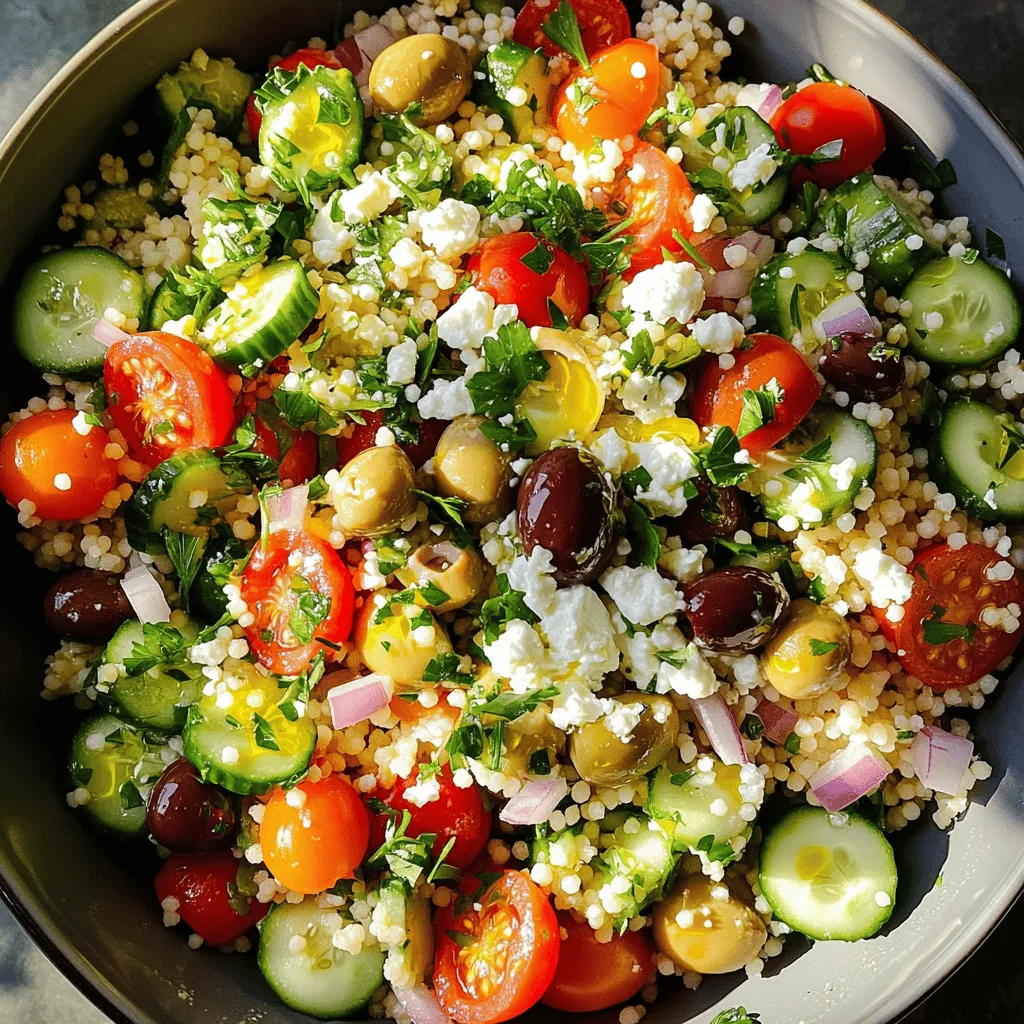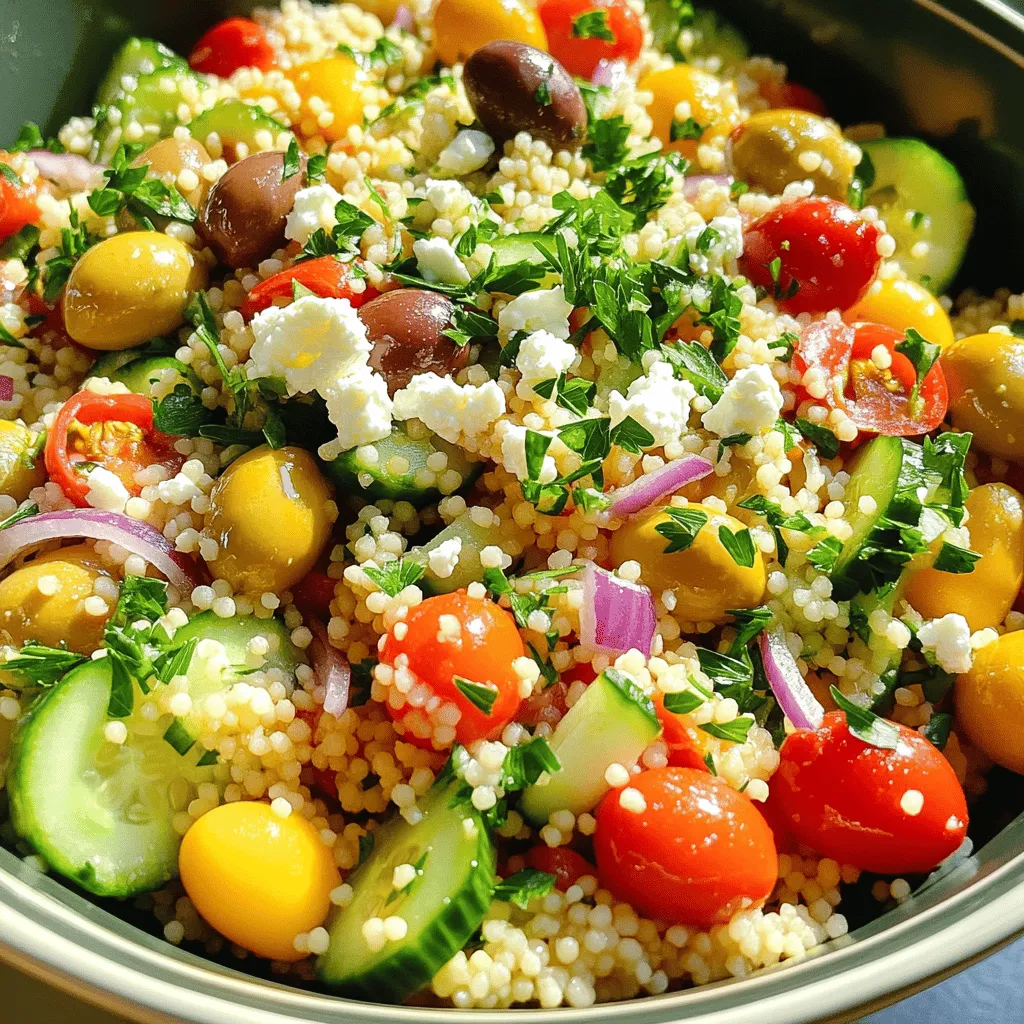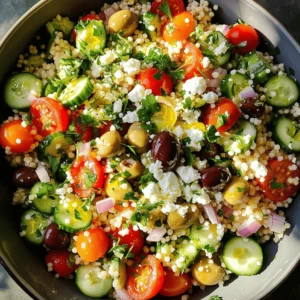Looking for a fresh and tasty dish to brighten your meals? This Mediterranean Couscous Salad is packed with flavor and color! With its blend of vibrant veggies, salty feta, and zesty dressing, it’s not just a salad—it’s an experience. Join me as we explore this easy and healthy recipe that you can whip up in no time. Let’s dive into the ingredients and get cooking!

Ingredients
Main Ingredients
– 1 cup couscous
– 1 1/2 cups vegetable broth
– 1 cup cherry tomatoes, halved
– 1 cucumber, diced
– 1/2 red onion, finely chopped
– 1/2 cup Kalamata olives, sliced
– 1/2 cup feta cheese, crumbled
– 1/4 cup fresh parsley, chopped
Couscous is the star of this salad. It is small, fluffy, and easy to cook. I use vegetable broth to give it a nice flavor. The fresh vegetables add color and crunch. Cherry tomatoes are sweet, while cucumbers are crisp. Red onions bring a bit of bite. Kalamata olives add a salty touch, and feta cheese gives a creamy finish. Fresh parsley brightens the dish with its green color.
Dressing Ingredients
– 1/4 cup olive oil
– 2 tablespoons lemon juice
– 1 teaspoon dried oregano
– Salt and pepper to taste
The dressing is simple but full of flavor. I mix olive oil and lemon juice to create a bright taste. Dried oregano adds an earthy note. I always season it with salt and pepper to balance the flavors.
Recommended Tools
– Saucepan
– Mixing bowl
– Whisk
– Fork
You will need a saucepan to cook the couscous. A mixing bowl is great for combining the salad. A whisk helps blend the dressing well. Lastly, a fork is perfect for fluffing the couscous. These tools make the process smooth and easy.
Step-by-Step Instructions
Cooking the Couscous
– Boiling Vegetable Broth
Start by pouring 1 and 1/2 cups of vegetable broth into a saucepan. Heat it on medium until it boils. Watch it closely so it doesn’t boil over.
– Adding Couscous
Once the broth is boiling, remove the pot from the heat. Add 1 cup of couscous to the broth and stir it gently. Cover the pot with a lid and let it sit for about 5 minutes. This helps the couscous soak up all the flavor.
– Cooling the Couscous
After 5 minutes, use a fork to fluff the couscous. This step makes it light and airy. Set it aside to cool down while you prepare the salad.
Preparing the Salad
– Chopping Fresh Ingredients
Take the time to chop your fresh vegetables. Dice 1 cucumber, halve 1 cup of cherry tomatoes, and finely chop 1/2 a red onion. Slice 1/2 cup of Kalamata olives. These add color and flavor.
– Combining Ingredients in a Bowl
In a large mixing bowl, combine the cooled couscous, chopped tomatoes, cucumber, onion, olives, and 1/2 cup of crumbled feta cheese. Add 1/4 cup of chopped fresh parsley for that fresh taste.
– Preparing the Dressing
In a small bowl, whisk together 1/4 cup of olive oil, 2 tablespoons of lemon juice, and 1 teaspoon of dried oregano. Season with salt and pepper to taste. This dressing pulls all the flavors together.
Final Assembly
– Mixing Salad and Dressing
Pour the dressing over the couscous mixture. Gently toss everything together. Make sure each ingredient gets coated well in the dressing.
– Adjusting Seasoning
Taste the salad and adjust the seasoning if needed. You can add more salt, pepper, or lemon juice for extra flavor.
– Chilling Time for Flavor
Cover the salad and chill it in the refrigerator for at least 30 minutes. This helps the flavors blend and creates a refreshing dish perfect for any occasion.
Tips & Tricks
Perfecting Couscous Texture
– Fluffing Techniques: After cooking, use a fork to fluff the couscous. This helps separate the grains and keeps it light. Fluffing is key for a great texture.
– Letting Couscous Cool: Let your couscous cool for a bit before mixing it with other ingredients. Cooling helps it absorb flavors better. It also prevents the salad from becoming soggy.
Seasonal Ingredient Suggestions
– Choosing Fresh Vegetables: Pick seasonal veggies for the best taste. Fresh cherry tomatoes and cucumbers make your salad crisp and bright. Adjust what you use based on what’s available.
– Adding Seasonal Herbs: Fresh herbs like basil or mint can elevate your dish. They add color and flavor. Use what you find at the market or in your garden for the best result.
Serving Suggestions
– Presentation Tips: Serve the salad in a large bowl for a family-style meal. You can also plate it individually for a nice touch. A colorful bowl makes your salad pop.
– Garnishing Ideas: Add whole olives and a sprig of parsley on top. This not only makes the dish look appealing but also adds a fresh flavor. Garnishes can really enhance the eating experience.

Variations
Dietary Adjustments
Gluten-Free Options
If you need a gluten-free dish, try using quinoa instead of couscous. Quinoa cooks similarly and adds a nice texture. Just rinse it well before cooking. You can also use gluten-free couscous made from corn or rice.
Vegan Adaptations
To make this salad vegan, skip the feta cheese. You can use avocado for creaminess. Also, try adding nutritional yeast for a cheesy flavor without dairy. This keeps the dish light and flavorful.
Add-Ins for Flavor
Protein Choices
You can add cooked chicken for a heartier meal. If you prefer plant-based protein, chickpeas work great. They add a nice bite and are full of fiber. You can also use tuna or shrimp for a seafood twist.
Different Cheeses
If feta isn’t your favorite, try goat cheese or even mozzarella. Each cheese gives a different taste. Goat cheese is tangy, while mozzarella is mild and creamy. Choose what you love best!
Flavor Enhancements
Spice Suggestions
To spice things up, add a pinch of red pepper flakes for heat. You could also sprinkle in some cumin for a warm flavor. Fresh herbs like mint or basil can brighten the dish, too.
Alternative Dressings
While olive oil and lemon juice are classic, you can experiment. Try a balsamic vinaigrette for a sweeter taste. A tahini dressing can add a nutty flavor that pairs well with the salad’s ingredients.
Storage Info
Storing Leftovers
– Refrigeration Tips: Store the salad in an airtight container. Keep it in the fridge. It stays fresh for up to three days. Make sure to cool it down before placing it inside. This helps maintain texture and flavor.
– Freezing Recommendations: Freezing is not ideal for this salad. The vegetables and feta may become mushy. If you must freeze, store only the couscous. Thaw it in the fridge before serving.
Shelf Life
– Timeline for Freshness: Enjoy the salad within three days for the best taste. After that, the flavors fade and ingredients lose their crunch.
– Signs of Spoilage: Look for wilting vegetables or off smells. If it looks slimy or has a sour scent, it’s best to discard it.
Reheating Instructions
– Best Practices for Serving Again: If you want to serve it cold, just take it out of the fridge. You can also gently reheat the couscous in the microwave. Add a splash of broth or water to keep it moist.
– Recommended Storage Containers: Use glass or plastic containers with tight lids. These help keep the salad fresh and flavorful.
FAQs
Can I use a different type of couscous?
Yes, you can! If you want a different texture, try larger couscous like pearl couscous. It has a chewy bite that adds fun to the salad. Quinoa is another great option. It is gluten-free and has a nutty flavor. Just remember to adjust the cooking time if you switch to quinoa. Cook it in water or broth for about 15 minutes until soft.
How long can I store Mediterranean Couscous Salad?
You can store the salad for about 3 days in the fridge. Keep it in an airtight container for best results. The flavors will keep getting better as it sits. Just make sure to check for freshness before you eat it. If it smells off or looks strange, it’s best to toss it.
What can I add to make it more filling?
To make your salad more filling, add protein! Here are some tasty ideas:
– Grilled chicken for a hearty boost.
– Canned chickpeas for a vegetarian option.
– Shrimp for a seafood twist.
– Hard-boiled eggs for extra richness.
– Roasted nuts for crunch and healthy fats.
Each option adds flavor and makes the dish more satisfying.
Mediterranean Couscous Salad brings fresh flavors and healthy choices to your table. You learned how to cook couscous, mix in fresh vegetables, and create a tasty dressing. Tips for perfect texture and seasonal ingredients help you adapt this dish. Whether you choose gluten-free or vegan options, there’s a way to make it work.
Store leftovers safely and enjoy later. This salad is easy to vary, making it a go-to recipe. Embrace the joy of cooking and enjoy every bite!

